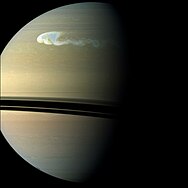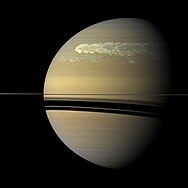The Great White Spot, also known as Great White Oval, on Saturn, named by analogy to Jupiter's Great Red Spot, is a series of periodic storms that are large enough to be visible from Earth by telescope by their characteristic white appearance. The spots can be several thousands of kilometers wide.
The Cassini orbiter was able to track the 2010–11 instance of the storm,[1] also known as the Northern Electrostatic Disturbance, because of an increase in radio and plasma interference, or the Great Springtime Storm.[2]
Cassini data has revealed a loss of acetylene in the white clouds, an increase of phosphine, and an unusual temperature drop in the center of the storm.[3] After the visible aspects of the storm subsided, in 2012, a "belch" of heat and ethylene was emitted from two hotspots that merged.[2][4]
- ^ Cassini Helps Solve Saturn’s Mysterious Great White Spots | Space Exploration | Sci-News.com
- ^ a b Mann, Adam. "Saturn Storm Creates Largest and Hottest Vortex Ever Seen in Solar System". Wired.
- ^ Krishnan, Shweta (May 20, 2011). "Dissecting Saturn's Big Storm". Sky & Telescope. Archived from the original on September 10, 2012. Retrieved May 22, 2011.
- ^ NASA: Rare, enormous gas storm detected on Saturn - CNN.com



